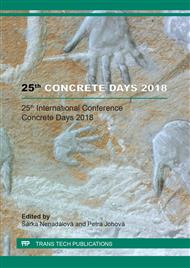[1]
EN 1992-1-1 Eurocode 2, Design of Concrete Structures – Part 1: General rules and rules for buildings, European Committee for Standardization, December 2004-2016.
Google Scholar
[2]
SCHLAICH, J.; SCHÄFER, K.; and JENNEWEIN, M., Toward a Consistent Design of Structural Concrete, PCI Journal, V. 32, No. 3, 1987, p.74–150.
DOI: 10.15554/pcij.05011987.74.150
Google Scholar
[3]
TJHIN, T.N., and KUCHMA, D.A.: Computer-based tools for design by strut-and-tie method: advances and challenges. ACI Structural Journal, vol. 99, no. 5: 586-594, (2002).
DOI: 10.14359/12298
Google Scholar
[4]
AStrutTie 2017. HanGil IT. Available at: http://astruttie.aroad.co.kr/. 31. 10. (2016).
Google Scholar
[5]
MARTI, P.: Truss models in detailing. Concrete International, 7(12), p.66–73, (1985).
Google Scholar
[6]
FERNÁNDEZ RUIZ, M. and MUTTONI, A.: On development of suitable stress fields for structural concrete. ACI Structural Journal, vol. 104, no. 4: 495–502, (2007).
Google Scholar
[7]
VECCHIO, F. J., and COLLINS, M. P.: The Modified Compression-Field Theory for Reinforced Concrete Elements subjected to Shear, ACI Journal, V. 83, No. 2, p.219–231.
DOI: 10.14359/10416
Google Scholar
[8]
KAUFMANN, W. and MARTI, P.: Structural Concrete: Cracked Membrane Model. Journal of Structural Engineering, ASCE, vol. 124: 1467–1475, (1998).
DOI: 10.1061/(asce)0733-9445(1998)124:12(1467)
Google Scholar
[9]
MATA-FALCÓN, J., TRAN, D., T., KAUFMANN, W., NAVRÁTIL, J.: Computer-aided stress field analysis of discontinuity concrete regions, In: Proceedings of the Conference on Computational Modelling of Concrete and Concrete Structures (EURO-C 2018), p.641–650, CRC Press, ISBN 978-1-138-74117-1, Austria, (2018).
DOI: 10.1201/9781315182964-77
Google Scholar
[10]
KAUFMANN, W., MATA-FALCÓN, J.: Structural Concrete Design in the 21st Century: are Limit Analysis Methods Obsolete? In: Proceedings of 24th Concrete Days 2017, Czech Republic, ISBN 978-80-906759-0-2, p.1–12, (2017).
Google Scholar
[11]
IDEA StatiCa Detail [online]. Available at: https://www.ideastatica.com/concrete/ 28. 11. (2018).
Google Scholar
[12]
Theoretical Background IDEA StatiCa Detail 2018 [online]. 28. 11. 2018. Available at: https://resources.ideastatica.com/Content/06_Detail/TB/IDEA%20Detail%20Theoretical%20Manual_ENG%20-%202018-10-11.pdf.
Google Scholar
[13]
NAVRÁTIL, J., ŠEVČÍK, P., MICHALČÍK, L., FOLTYN, P., KABELÁČ, J.: Řešení stěn a detailů betonových konstrukcí (Solution for walls and details of concrete structures), In: Proceedings of 24th Concrete Days 2017, ISBN 978-80-906759-0-2, p.1–7, Czech Republic, (2017).
Google Scholar
[14]
MARTI, P., ALVAREZ, M., KAUFMANN, W. and SIGRIST, V.: Tension Chord Model for Structural Concrete. Structural Engineering International. 8. 287-298. (1998).
DOI: 10.2749/101686698780488875
Google Scholar


